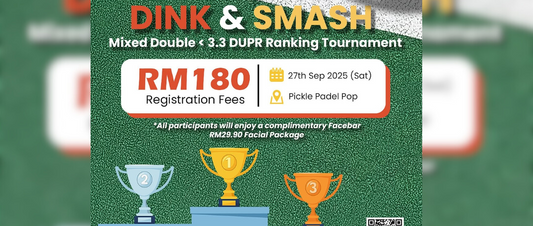
Are You a 2.0, 3.0, or 4.0 Pickleball Player? How to Assess Yourself
Andrew LeeIn pickleball, knowing your skill level is essential for fair matches and tracking progress. It assigns a numeric skill level (2.0 to 5.0+) based on match performance and results, ensuring accurate and fair rankings across all levels.
Pickleball started as a fun hobby, but now it’s a passion - you’re on the courts every chance you get. You know you’ve improved, but where do you actually stand? It’s a question every player asks at some point.
Most players gauge their level through self-rating, this article explains pickleball ratings, in general explaining what they are, how they work, and their importance in the pickleball community.
⭐ 1.0: First Time Racquet Player
Your ball flies in every possible and impossible direction. Yes, you are an absolute beginner, you can’t hit the ball 10 out of 10 times.
⭐ 2.0: Beginner (You will pick freaking lots of balls)
You are just starting and learning the basics. You can hit the ball but struggle with consistency, positioning, and strategy.
- Forehand: Basic but inconsistent.
- Backhand: Rarely used.
- Serve / Return: Weak, often short.
- Dink: Inconsistent, often hits out or into the net.
- 3rd Shot: No real strategy, just hits the ball back.
- Volley: Limited control, avoids the net.
- Strategy: No court awareness, plays randomly.
How to Improve to Next Level
- Drill, drill, drill: Hit against a wall or with a partner to improve ball control.
- Master the rules: Watch beginner guides and understand scoring.
- Play more games: Join beginner-friendly open plays.
⭐⭐ 2.5: Social Beginner (You will pick a lot of balls)
You can sustain short rallies but still lack control over shot placement. You may also hesitate at the net.
- Forehand: More consistent but lacks power.
- Backhand: Can return easy shots but avoids it.
- Serve / Return: Sometimes deep, but lacks placement.
- Dink: Starts to understand soft play but often mishits.
- 3rd Shot: Tries to drop but lacks accuracy.
- Volley: Can volley but lacks direction and soft hands.
- Strategy: No control over shot selection.
How to Improve to Next Level
- Consistent Serves & Returns: Aim for deeper shots to keep opponents back.
- Dinking Practice: Soft shots near the net force errors in your favor.
- Learn Basic Strategy: Move with your partner and cover the court better.
⭐⭐⭐ 3.0 - 3.5: Recreational Intermediate
You’re getting better at keeping the ball in play and understanding how to move. You can control rallies and place shots, but still struggle against aggressive or more experienced players. Unforced errors and weak third-shot drops may still hurt your game.
- Forehand: Reliable with moderate spin and placement.
- Backhand: Can execute but still weaker than forehand.
- Serve / Return: Good consistency and better placement.
- Dink: Keeps dinks low but struggles under pressure.
- 3rd Shot: Developing a consistent drop shot.
- Volley: Handles medium-speed shots, but lacks finesse.
- Strategy: Starts to think about shot selection and positioning.
How to Improve to Next Level
- Third-Shot Drop Drills: This soft shot is key to advancing your game.
- Improve Net Play: Get comfortable at the kitchen line for quick volleys.
- Join Local Leagues: Competitive play helps refine decision-making.
- Develop a Powerful Drive: A strong forehand/backhand will keep opponents on their heels.
- Improve Reaction Time: Fast hands are crucial at the kitchen line.
- Work on Court Positioning: Don’t get caught in the “dead zone” (mid-court).
⭐⭐⭐⭐ 4.0 - 4.5: Advanced, Semi Pro
At this level, you have consistent shots, understand advanced strategies, and attack when needed.
- Forehand: Powerful and precise with spin.
- Backhand: Confident, can drive and slice effectively.
- Serve / Return: Deep, accurate, sometimes aggressive.
- Dink: Soft and controlled, places shots strategically.
- 3rd Shot: Drops or drives based on the opponent’s weakness.
- Volley: Can attack at the net with control and quick reflexes.
- Strategy: Controls rallies, forces opponents into weak positions.
How to Improve to Next Level
- Refine Spin & Control: Learn to mix top-spin and slice.
- Master Defensive Blocks: When under attack, reset points with controlled blocks.
- Play Against Stronger Opponents: Challenging games help break bad habits.
⭐⭐⭐⭐⭐ 5.0+ - Professional
You dictate play, force errors, and adapt quickly. Players here have complete control over all aspects of the game.
- Forehand: Heavy spin, sharp angles, aggressive placement.
- Backhand: Equally strong, used for attacking and countering.
- Serve / Return: Unpredictable, deceptive, and strategic.
- Dink: Can control tempo and set up offensive plays.
- 3rd Shot: Reads the opponent’s position and varies approach.
- Volley: Fast, aggressive, and precise at the kitchen.
- Strategy: Dictates play, adapts instantly, minimizes mistakes.
How to Improve to Next Level
- Mental Game & Conditioning: Staying composed in high-pressure moments is key.
- Advanced Shot Variations: Master roll volleys, speed-ups, and deceptive shots.
- Coach & Pro-Level Drills: Refining weaknesses takes structured training.
Here's a quick video to help you understand the level of game play
Understanding your rating helps you track progress and compete at the right level. Whether you’re a beginner (2.0), an intermediate player (3.5), or striving to go pro (5.0+), improving shot accuracy, consistency, and strategy is key.
Want to boost your skills? Find a pickleball coach or training partner and level up your game!









